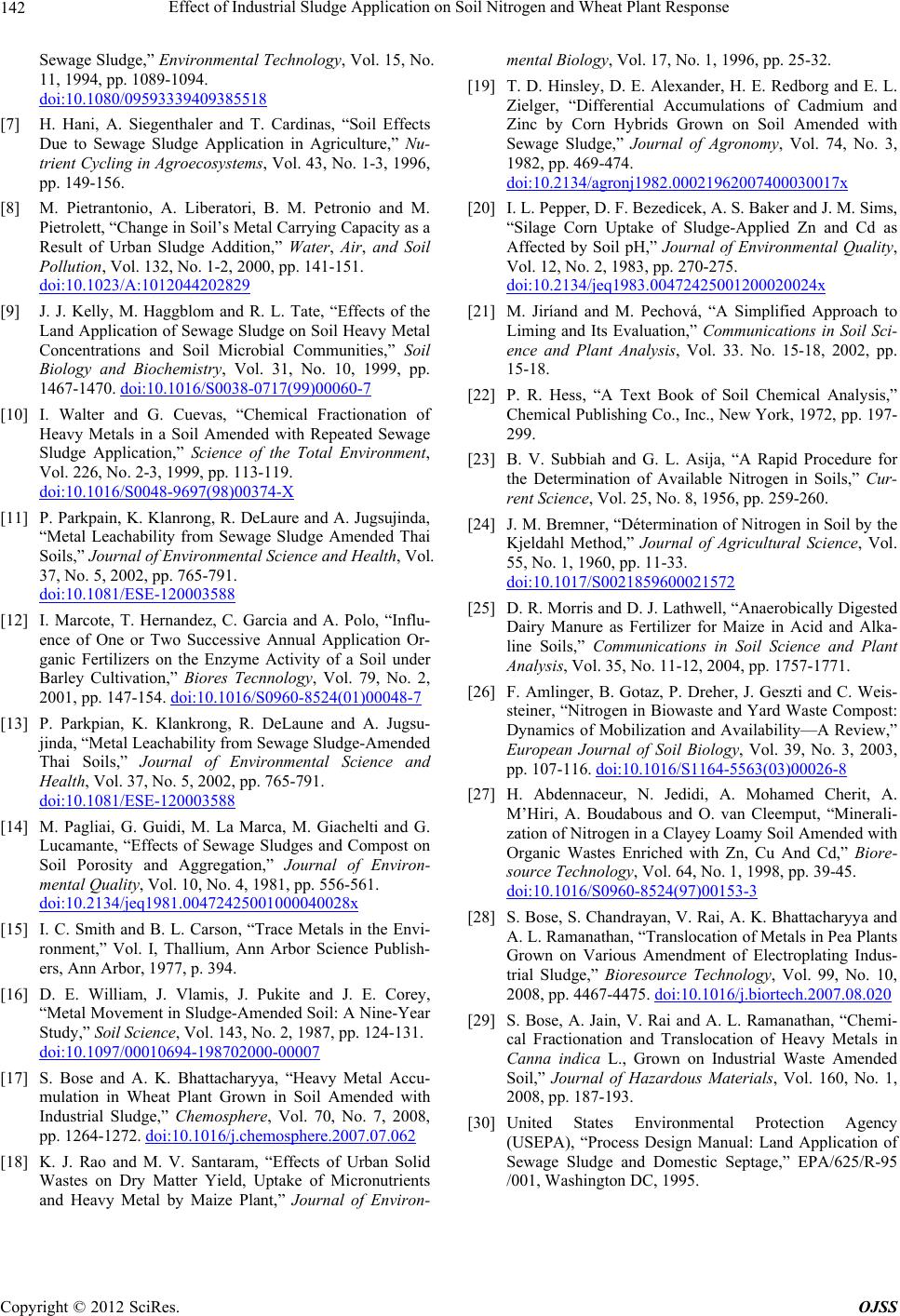
Effect of Industrial Sludge Application on Soil Nitrogen and Wheat Plant Response
142
Sewage Sludge,” Environmental Technology, Vol. 15, No.
11, 1994, pp. 1089-1094.
doi:10.1080/09593339409385518
[7] H. Hani, A. Siegenthaler and T. Cardinas, “Soil Effects
Due to Sewage Sludge Application in Agriculture,” Nu-
trient Cycling in Agroecosystems, Vol. 43, No. 1-3, 1996,
pp. 149-156.
[8] M. Pietrantonio, A. Liberatori, B. M. Petronio and M.
Pietrolett, “Change in Soil’s Metal Carrying Capacity as a
Result of Urban Sludge Addition,” Water, Air, and Soil
Pollution, Vol. 132, No. 1-2, 2000, pp. 141-151.
doi:10.1023/A:1012044202829
[9] J. J. Kelly, M. Haggblom and R. L. Tate, “Effects of the
Land Application of Sewage Sludge on Soil Heavy Metal
Concentrations and Soil Microbial Communities,” Soil
Biology and Biochemistry, Vol. 31, No. 10, 1999, pp.
1467-1470. doi:10.1016/S0038-0717(99)00060-7
[10] I. Walter and G. Cuevas, “Chemical Fractionation of
Heavy Metals in a Soil Amended with Repeated Sewage
Sludge Application,” Science of the Total Environment,
Vol. 226, No. 2-3, 1999, pp. 113-119.
doi:10.1016/S0048-9697(98)00374-X
[11] P. Parkpain, K. Klanrong, R. DeLaure and A. Jugsujinda,
“Metal Leachability from Sewage Sludge Amended Thai
Soils,” Journal of Environmental Science and Health, Vol.
37, No. 5, 2002, pp. 765-791.
doi:10.1081/ESE-120003588
[12] I. Marcote, T. Hernandez, C. Garcia and A. Polo, “Influ-
ence of One or Two Successive Annual Application Or-
ganic Fertilizers on the Enzyme Activity of a Soil under
Barley Cultivation,” Biores Tecnnology, Vol. 79, No. 2,
2001, pp. 147-154. doi:10.1016/S0960-8524(01)00048-7
[13] P. Parkpian, K. Klankrong, R. DeLaune and A. Jugsu-
jinda, “Metal Leachability from Sewage Sludge-Amended
Thai Soils,” Journal of Environmental Science and
Health, Vol. 37, No. 5, 2002, pp. 765-791.
doi:10.1081/ESE-120003588
[14] M. Pagliai, G. Guidi, M. La Marca, M. Giachelti and G.
Lucamante, “Effects of Sewage Sludges and Compost on
Soil Porosity and Aggregation,” Journal of Environ-
mental Quality, Vol. 10, No. 4, 1981, pp. 556-561.
doi:10.2134/jeq1981.00472425001000040028x
[15] I. C. Smith and B. L. Carson, “Trace Metals in the Envi-
ronment,” Vol. I, Thallium, Ann Arbor Science Publish-
ers, Ann Arbor, 1977, p. 394.
[16] D. E. William, J. Vlamis, J. Pukite and J. E. Corey,
“Metal Movement in Sludge-Amended Soil: A Nine-Year
Study,” Soil Science, Vol. 143, No. 2, 1987, pp. 124-131.
doi:10.1097/00010694-198702000-00007
[17] S. Bose and A. K. Bhattacharyya, “Heavy Metal Accu-
mulation in Wheat Plant Grown in Soil Amended with
Industrial Sludge,” Chemosphere, Vol. 70, No. 7, 2008,
pp. 1264-1272. doi:10.1016/j.chemosphere.2007.07.062
[18] K. J. Rao and M. V. Santaram, “Effects of Urban Solid
Wastes on Dry Matter Yield, Uptake of Micronutrients
and Heavy Metal by Maize Plant,” Journal of Environ-
mental Biology, Vol. 17, No. 1, 1996, pp. 25-32.
[19] T. D. Hinsley, D. E. Alexander, H. E. Redborg and E. L.
Zielger, “Differential Accumulations of Cadmium and
Zinc by Corn Hybrids Grown on Soil Amended with
Sewage Sludge,” Journal of Agronomy, Vol. 74, No. 3,
1982, pp. 469-474.
doi:10.2134/agronj1982.00021962007400030017x
[20] I. L. Pepper, D. F. Bezedicek, A. S. Baker and J. M. Sims,
“Silage Corn Uptake of Sludge-Applied Zn and Cd as
Affected by Soil pH,” Journal of Environmental Quality,
Vol. 12, No. 2, 1983, pp. 270-275.
doi:10.2134/jeq1983.00472425001200020024x
[21] M. Jiríand and M. Pechová, “A Simplified Approach to
Liming and Its Evaluation,” Communications in Soil Sci-
ence and Plant Analysis, Vol. 33. No. 15-18, 2002, pp.
15-18.
[22] P. R. Hess, “A Text Book of Soil Chemical Analysis,”
Chemical Publishing Co., Inc., New York, 1972, pp. 197-
299.
[23] B. V. Subbiah and G. L. Asija, “A Rapid Procedure for
the Determination of Available Nitrogen in Soils,” Cur-
rent Science, Vol. 25, No. 8, 1956, pp. 259-260.
[24] J. M. Bremner, “Détermination of Nitrogen in Soil by the
Kjeldahl Method,” Journal of Agricultural Science, Vol.
55, No. 1, 1960, pp. 11-33.
doi:10.1017/S0021859600021572
[25] D. R. Morris and D. J. Lathwell, “Anaerobically Digested
Dairy Manure as Fertilizer for Maize in Acid and Alka-
line Soils,” Communications in Soil Science and Plant
Analysis, Vol. 35, No. 11-12, 2004, pp. 1757-1771.
[26] F. Amlinger, B. Gotaz, P. Dreher, J. Geszti and C. Weis-
steiner, “Nitrogen in Biowaste and Yard Waste Compost:
Dynamics of Mobilization and Availability—A Review,”
European Journal of Soil Biology, Vol. 39, No. 3, 2003,
pp. 107-116. doi:10.1016/S1164-5563(03)00026-8
[27] H. Abdennaceur, N. Jedidi, A. Mohamed Cherit, A.
M’Hiri, A. Boudabous and O. van Cleemput, “Minerali-
zation of Nitrogen in a Clayey Loamy Soil Amended with
Organic Wastes Enriched with Zn, Cu And Cd,” Biore-
source Technology, Vol. 64, No. 1, 1998, pp. 39-45.
doi:10.1016/S0960-8524(97)00153-3
[28] S. Bose, S. Chandrayan, V. Rai, A. K. Bhattacharyy a and
A. L. Ramanathan, “Translocation of Metals in Pea Plants
Grown on Various Amendment of Electroplating Indus-
trial Sludge,” Bioresource Technology, Vol. 99, No. 10,
2008, pp. 4467-4475. doi:10.1016/j.biortech.2007.08.020
[29] S. Bose, A. Jain, V. Rai and A. L. Ramanathan, “Chemi-
cal Fractionation and Translocation of Heavy Metals in
Canna indica L., Grown on Industrial Waste Amended
Soil,” Journal of Hazardous Materials, Vol. 160, No. 1,
2008, pp. 187-193.
[30] United States Environmental Protection Agency
(USEPA), “Process Design Manual: Land Application of
Sewage Sludge and Domestic Septage,” EPA/625/R-95
/001, Washington DC, 1995.
Copyright © 2012 SciRes. OJSS